September 11 – 15, 2011
For this section of locks, after leaving Lock 11, we ended up spending one night at Lock 9 and four nights at Lock 7. I'm going to divide the post into canal scenery for the lock series and then Lock 7 history and activities.
As a reminder, the Champlain Canal from Locks 12 – 7 is a 24 mile man-made, mostly straight “ditch”, with little variation in the width and a defined depth. Below Lock 7, you begin traveling on the Hudson River portion of the Canal for the remaining 36 miles. Like most natural rivers, it is winding, with a variable width and depth. It is critical to follow the navigational markers to avoid rocks and shoals.
The smell of dairy farms is ever present. Some of the cows are right next to the canal. We even went by a pig farm, and did that ever have a pungent odor! All the muddy, rainy weather suited the pigs just fine; they were covered with mud, rooting and wagging their curly piggy tails.
The scenery isn't just “flat” canalside views. There are vistas with a bit of hilly terrain and variations in the vegetation so that you won't be bored creeping along the Canal. You will go by the Saratoga Battlefield National Park and be able to see how the elevated terrain would be a great lookout post over the river.
After we left Lock 9 we could see a 4' high water mark as indicated by a deposit of fine mud sticking to the canalside vegetation. That is a lot considering it was in a section with better controllable depths and not the free-flowing river. We didn't realize what water depth deposits we would sadly see as we got further downstream. Flooded lands, with lots of standing water, have become breeding places for mosquitoes, and they are out in full force on our walks.
I saw this canal monster basking in the sun in someone's yard.
Temperatures have begun to drop into the 40s at night. There is evidence that Fall is coming by subtle changes in the the colors of the leaves on some of the trees. I wish we could be up here for the full color change, but we would be too cold most of the time. Plus, we get so much condensation on the inside of the boat I have to use towels to wipe the window frames.
Another sign of Fall are the milkweed plant pods bursting open. Some fields will be white with all the seeds getting airborne when the wind picks up.
I wasn't sure what I was seeing when I was walking Ursa and saw a big white dome sticking out of a grassy field. Even when I walked over and touched it I still wasn't sure what it was since it felt like smooth leather. Looking around, I could see a couple of other ones which had split apart and browned up. I could also tell it was attached to the ground, so then I knew it was a gigantic puff ball, the biggest I have ever seen. I had Ursa sit next to it to give you a perspective for its size.
Locks 6, 7, and 8 are associated with the town of Fort Edward, NY. Cruisers wishing to tour historic Ft. Edward and/or stop there for shopping errands typically stay at Lock 7. There are 3 choices to tie up. The town wall, with an adjacent park, right next to the Scotties factory, is the nicest and best located, has free electric and water, but if you are southbound you have to go through Lock 7 and then under a low bridge to get to it. Plus, it is located on the Hudson River so if the river is in a rage it's not the best place to tie up. We couldn't fit under the bridge, and the water depth next to the town wall is too shallow for us.
A lot of boaters tie up on the Lock 7 wall, north and west of the lock. When we got there, all those spaces were filled up, so we tied up on the floating dock north of the bridge north of Lock 7. The floating dock is right in front of a tiny park associated with the Old Fort House Museum complex, and it was a good place for us.
If you want to get tourist information, you need to walk to the Wing-Northrup House, 1815. The Washington Country Historical Society runs the place, and you can pick up brochures and talk to volunteers. The house itself is interesting to see.
Back in the mid-1700s the British constructed Fort Edward to run part of their military operations for fighting in the French and Indian War. The area was known as “The Carrying Place” because it was the end of the navigable part of the Hudson River. Boats would have to unload and then get carried to nearby Lake George in order to keep moving north to Lake Champlain since the Canal didn't exist then. Thus, Fort Edward was in a strategic position to be able to control the waterway from the south and north.
Rogers Island Visitors Center is a good place to visit to learn about the archeology and early history of Fort Edward. Displays indicate Native Americans, mostly the Mohicans and Mohawks inhabited the area as long ago as 6,000 BC. Modern excavations have turned up a lot of their artifacts, including some grave sites. Several yards of local residents have yielded artifacts when constructing additions to homes or basements that required digging.
The Island is named for Robert Rogers, leader of Rogers' Rangers. You can watch a TV segment from one of those history shows which tells the story of Robert Rogers. Rogers was arrested for counterfeiting, but rather than serve a prison sentence, he volunteered to command a renegade band of militiamen attached to the British Army for the Seven Year War. The band was mostly composed of men who had lost family members from Indian attacks, and the men wanted revenge. The Rangers went behind enemy lines for reconnaissance and killing raids, patterning their stealth warfare techniques after those used by the Indians. The British soldiers scoffed at the crude ways of the Rangers, but with many continued successful missions, Rogers reached rank of Major and trained some squads of British soldiers. The Rogers' Rangers proved so successful, many members went on to become leaders of the American Revolutionary War. And now you know the rest of the story.
Constructed in 1772 using timbers taken from the ruins of Fort Edward, the Old Fort House was built as a private residence for Patrick Smyth. However, it ended up being used as a headquarters by both the Americans and British during the Revolutionary War. You can tour it and several other buildings on the property.
The most noticeable waterfront activity happening at Ft. Edward is the controversial GE PCB dredging project. From 1948 – 1977 a GE factory on the Hudson River in Ft. Edward dumped PCBs into the river with approval of the NY DEC.
After years of legal presentations, in 2002, several environmental organizations won a suit to have the PCB contaminated sediment removed from the river bottom. GE agreed to cooperate with the EPA on the cleanup. Many people were not happy to have the massive project get underway since all the evidence did not indicate that the PCBs were as harmful as might be thought. Since they were buried deeply and bound under the sediment, some people felt that leaving them there would be okay compared to disrupting the river bottom, building ancillary facilities on the shore, having petroleum powered heavy equipment operating on the river, noise pollution, and a host of other factors. So, they decided to implement Phase 1 in 2009 and see how that went.
The plan called for the 2.4 million cubic yards of sediment to be dredged from a 40 mile stretch of the river and then transported to a landfill. Dredging operations run 24 hours/day, six days/week. A dewatering facility had to be constructed by Lock 8, about 2 miles from where the dredging is taking place. The “dry” sediment is shipped by train to Texas or Idaho.
To date, Phase 1 has collected 35,000 lbs PCBs from 286,000 cubic yards of Hudson River mud. GE has spent $561M, employing 250 contractors with 500 workers. The total mud which will be removed is conservatively estimated to fill 4 football stadiums. However, the PCBs were found to have sunk even deeper than expected, so the dredges are having to dig deeper, pulling up even more sediment to get to the PCB layer. One landowner whose property is adjacent to the dried sediment mountain complained that dust from the pile blows off to the surrounding lands.
Clean fill is supposed to be dumped into the excavated river bottom and then the area is supposed to be planted with indigenous plants. An archeologist is employed to analyze the dredged material for anything of historical value.
Many barge loads of sediment go through Lock 7 each day, and recreational vessels have to wait for the commercial traffic. Cruisers also have to navigate through the dredge area, communicating with the dredge captains for passage information.
There are multiple dredges working at the same time. Some barges carry the river sediment and some carry the clean fill. At least they go in two different directions so they don't have to tie up the lock. Only the PCB barge goes through the lock.
Boating traffic has to pay attention to what is happening with the barges. You can't rely on the chart markers because the barges dictate where the traffic can pass.
The morning we were leaving we could hear a lot of radio chatter about one of the barges taking on water and being in danger of sinking. Divers had to be brought out to dive under the barge to see what could be done. We went by and never heard the result.
We saw dozens of barges pass where we were docked and wondered how come they looked so clean when we could see the big clam shells dropping the splattering mud into the barge. This guy in the hazmat suit hammed up for Eddie's shot. His job was to shovel the overflow caught up on the edge of the barge back into the hold.
The Federal Lock at Troy finally opened on the 13th, so now all the boaters can get going again. Wayne and Eddie decided to remove the satellite dome and search light, getting us down to 16', a little better margin to get under the lowest bridge which still lies ahead for us. Unfortunately, we don't have to worry about if our antennas are up any more!
Saturday, September 24, 2011
Subscribe to:
Post Comments (Atom)

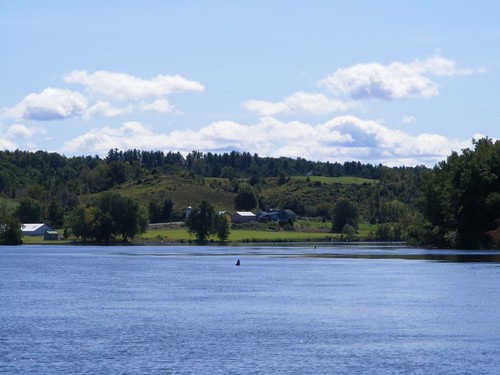
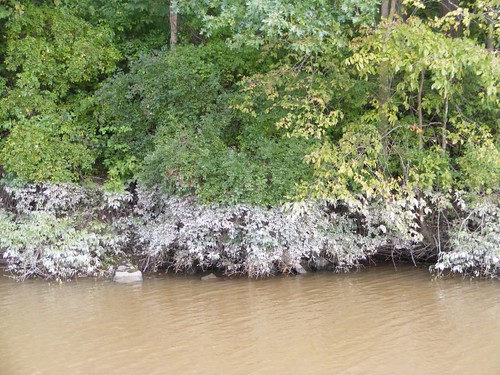
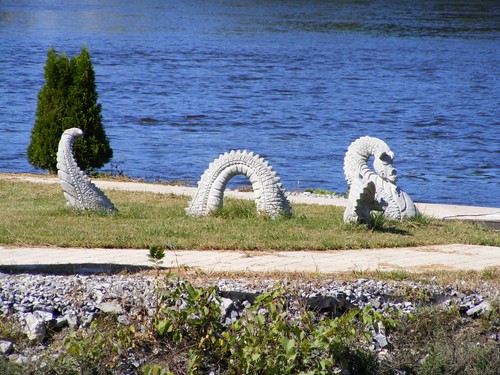
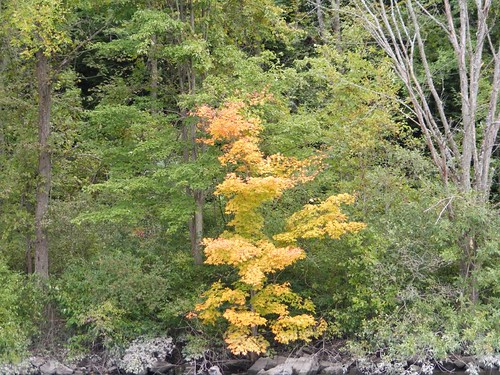
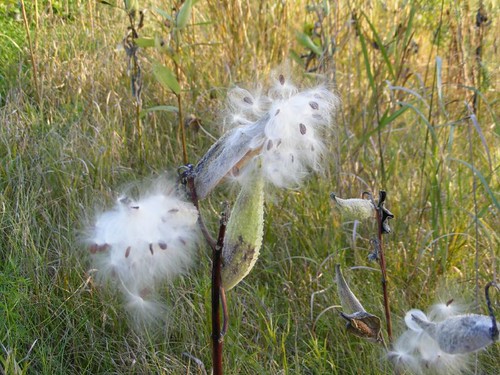

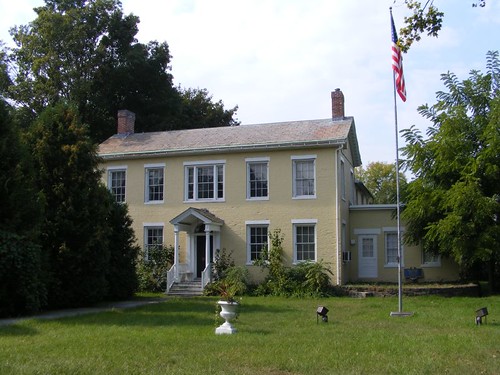
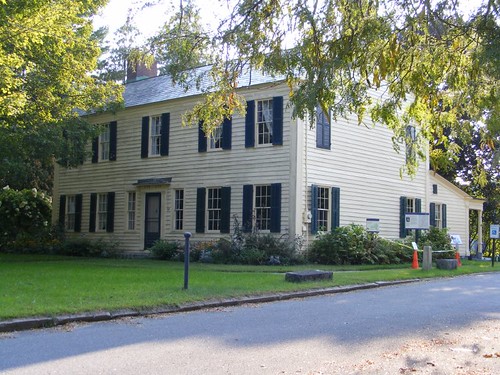
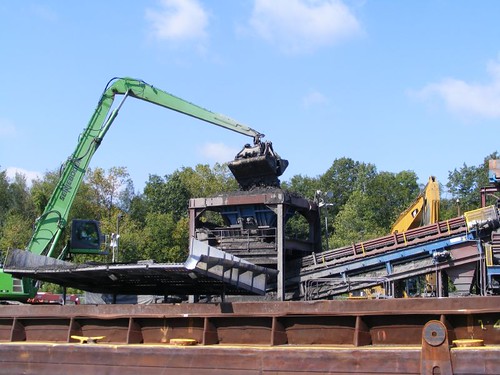
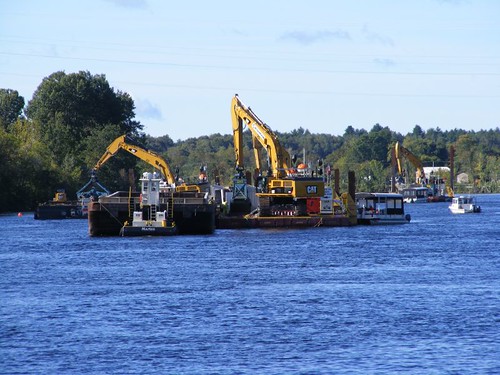
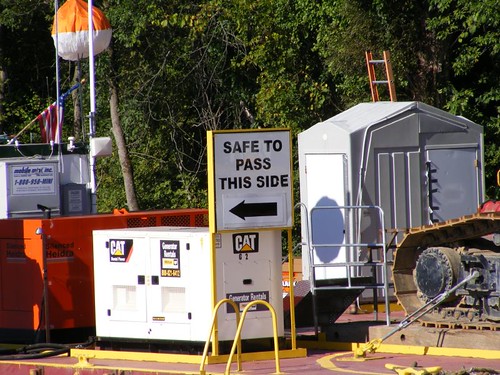
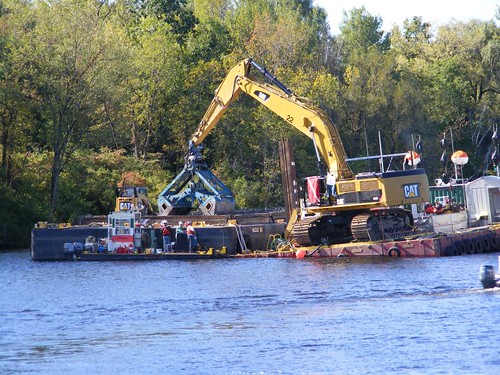









“Curiouser and curiouser!” Cried Alice. - from Alice's Adventures in Wonderland by Lewis Carroll! and with the Cheshire Dog, no less! Amazing!!!
ReplyDeletehandymanalex
I have never before seen fungus of that magnitude!
ReplyDeleteGreat pics!
Thanks,
Jerry